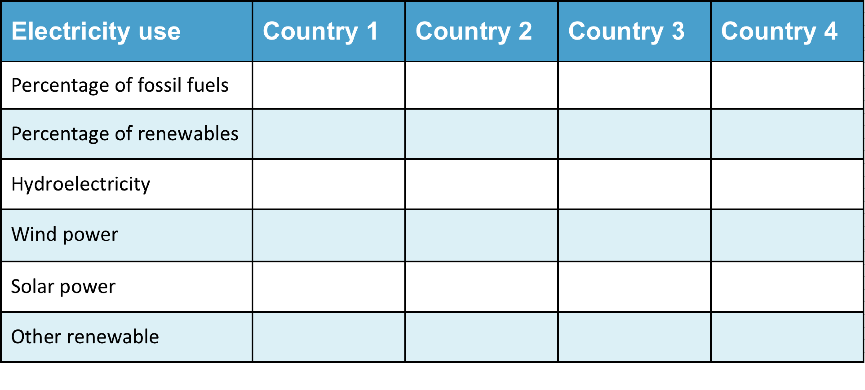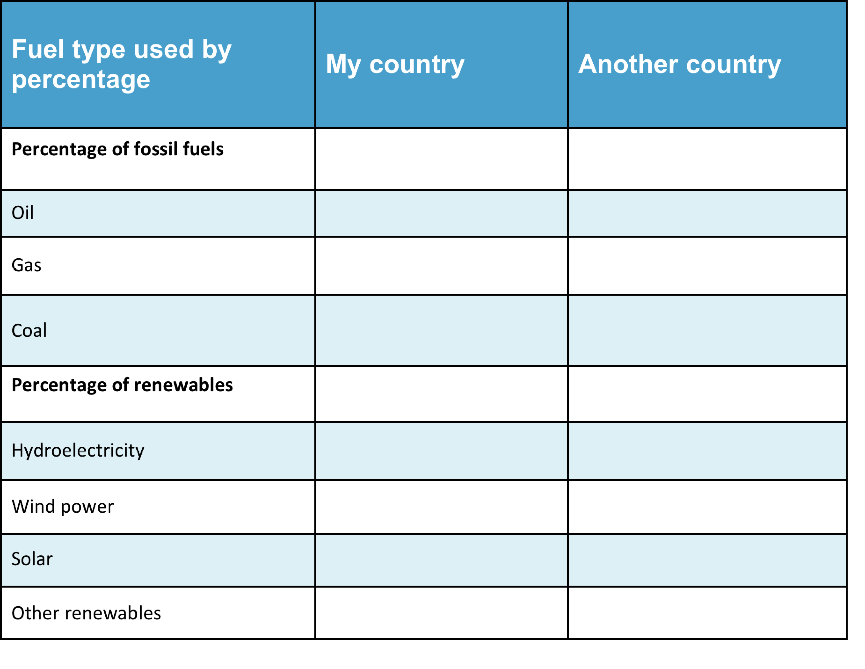Information for Teachers
Curriculum links
Australian Science Standards
CS (ACSSU074) Nature and uses of common materials
CS (ACSSU074) Uses of materials based on their properties
DT (ACTDEK013) Suitability of materials, systems, components, tools and equipment for particular purposes
UIS (ACSHE062) Science knowledge helps people to understand the effect of their actions
New Zealand Science Achievement Objectives
PW: The patterns associated with physical phenomena found in everyday situations involving movement, forces, electricity and magnetism, light, sound, waves and heat
PW: The properties of different groups of substances are linked to the way they are used in society or occur in nature
Helpful websites
You may want to direct your students to some or all of these websites to help with their investigations.
The Australian Climate Council website has clear reports about countries increasing their renewable energy:
https://www.climatecouncil.org.au/11-countries-leading-the-charge-on-renewable-energy
Ecowatch reports on five countries moving toward 100% renewable energy:
https://www.ecowatch.com/5-countries-leading-the-way-toward-100-renewable-energy-1881999459.html
The World Atlas lists the top 20 producers of renewable energy by country:
https://www.worldatlas.com/articles/top-15-countries-using-renewable-energy.html
and heavy users of fossil fuels here:
https://www.worldatlas.com/articles/countries-the-most-dependent-on-fossil-fuels.html
This site compares fossil fuel use in 138 countries:
https://www.indexmundi.com/facts/indicators/EG.USE.COMM.FO.ZS/rankings
Energy sites for kids:
How to search the internet
1 Keep your request short
Fewer words will give a more accurate search.
2 Choose exactly what you want
For example: Arctic Circle Climate
3 Use quotes
Double quotes around a set of words tell the search engine to consider those exact words in that exact order without any change. For example: “Arctic Circle Climate”
4 Use the plus sign (+)
If you add a plus sign (+) between words, the internet will search for all the words. For example: migrate+birds+whales+mammal
5 Use the minus sign (–) to say what you don’t want
Use a minus sign (–) to show words you do not want to appear in your results. For example: if you search for burrowing animals and do not want mammals in your search, –mammals will exclude mammals. Note that you need to put a space before the minus sign for the word to be excluded.
6 Be very clear about what you don’t want
Part 1
Ask questions and make predictions
After reading It’s All About Energy, you may have many questions about the amount of energy we use and how we make that energy.
List your questions
- Compare your list with questions that others have.
- Choose a question you would like to investigate.
- You can work alone, with a partner, or in a small group.
You may want to choose one or more of these questions to investigate
Q1. People often compare different countries when they talk about energy use. You might like to choose some countries to compare. You could choose to compare other countries with your country or other countries that are similar to the one where you live. You could compare how much energy is used or how they produce their energy (coal, oil, natural gas, hydroelectricity, wind, solar).
Q2. How many countries can you find that create most of their electricity from renewable energy?
Q3. Which countries use the most electricity per person?
Go to Part 2 Plan and investigate →Part 2
Plan and investigate
Do searches in the internet or in books or talk to people who can help to find the information you are looking for.
Your teacher may suggest suitable websites for further information.
Go to Part 3 Record and analyse data →Part 3
Record and analyse data
Find ways of recording your information that will allow you to see any patterns in the data.
Data Chart for comparing electricity generation by country
 Download Chart
Download Chart
Go to Part 4 Evaluate the information →
Part 4
Evaluate the information
1. Look over the information you have gathered and the patterns you have found.
How do the natural resources found in a country influence how it produces electricity? Why do they need to do this?
Do you think countries will be able to change the way they produce electricity?
Do you think countries will want to change the way they produce electricity?
2. Search for other patterns.
What do these patterns tell you about climate change? Why? What might happen in the future?
3. Make notes about what you find.
Go to Part 5 Communicate and share ideas →Part 5
Communicate and share ideas
Look over all of the information that you have gathered in your investigation.
What are the most important ideas about your topic?
Make a chart that compares electricity generation in your country with another country.
 Download Chart
Download Chart
← Return to menu
